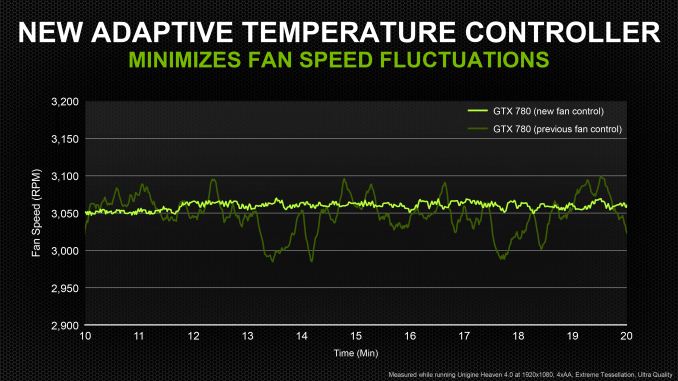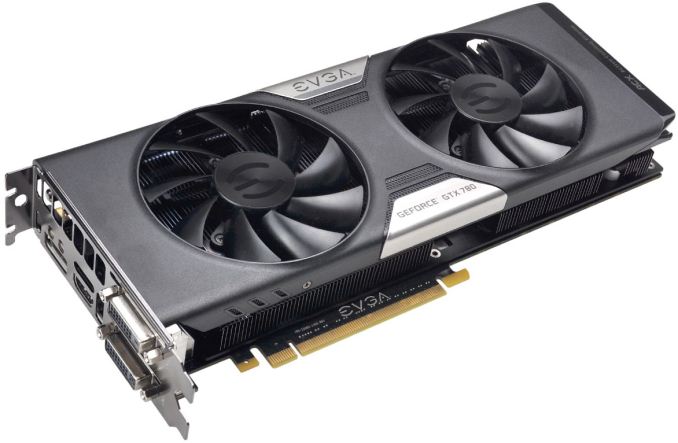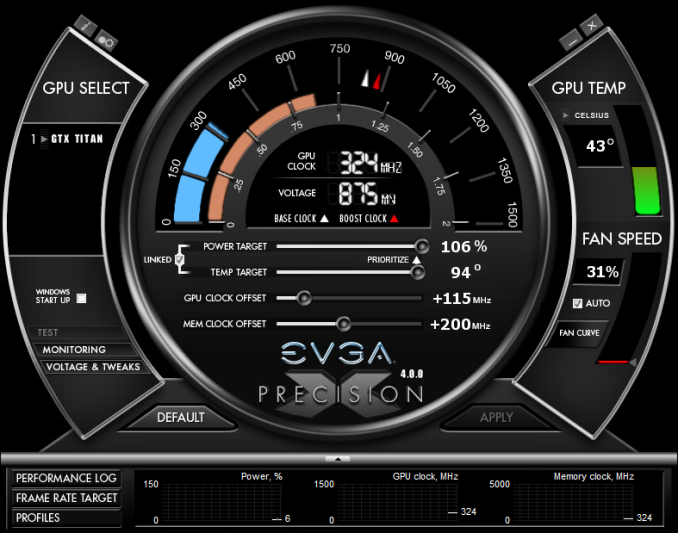NVIDIA GeForce GTX 780 Review: The New High End
by Ryan Smith on May 23, 2013 9:00 AM ESTMeet The GeForce GTX 780, Cont
With all of that said, GTX 780 does make one notable deviation from GTX Titan. NVIDIA has changed their stock fan programming for GTX 780, essentially slowing down the fan response time to even out fluctuations in fan speeds. NVIDIA has told us that they’ve found that next to loud fans in general, the second most important factor in fan noise becoming noticeable is rapidly changing fan speeds, with the changing pitch and volume drawing attention to the card. Slowing down the response time in turn will in theory keep the fan speed from spiking so much, or quickly dropping (i.e. loading screen) only to have to immediately jump back up again.
In our experience fan response times haven’t been an issue with Titan or past NVIDIA cards, and we’d be hard pressed to tell the difference between GTX 780 and Titan. With that said there’s nothing to lose from this change, GTX 780 doesn’t seem to be in any way worse for it, so in our eyes there’s no reason for NVIDIA not to go ahead with the change.
On that note, since this is purely a software(BIOS) change, we asked NVIDIA about whether this could be backported to the hardware equivalent Titan. The answer is fundamentally yes, but because NVIDIA doesn’t have a backup BIOS system, they aren’t keen on using BIOS flashing any more than necessary. So an official (or even unofficial) update from NVIDIA is unlikely, but given the user community’s adept BIOS modding skills it’s always possible a 3rd party could accomplish this on their own.
Moving on, unlike Titan and GTX 690, NVIDIA will be allowing partners to customize GTX 780, making this the first line of GK110 cards to allow customization. Potential buyers that were for whatever reason disinterested in Titan due to its blower will find that NVIDIA’s partners are already putting together more traditional open air cooler coolers for GTX 780. We can’t share any data about them yet – today is all about the reference card – but we already have one such card in-hand with EVGA’s GeForce GTX 780 ACX.
The reference GTX 780 sets a very high bar in terms of build quality and performance, so it will be interesting to see what NVIDIA’s partners can come up with. With NVIDIA testing and approving all designs under their Greenlight program, all custom cards have to meet or beat NVIDIA’s reference card in factors such as noise and power delivery, which for GTX 780 will not be an easy feat. However because of this requirement it means NVIDIA’s partners can deviate from NVIDIA’s reference design without buyers needing to be concerned that custom cards are significantly worse than then reference cards, something that benefits NVIDIA’s partners by their being able to attest to the quality of their products (“it got through Greenlight”), and benefitting buyers by letting them know they’re getting something that will be as good as the reference GTX 780, regardless of the specific make or model.
On that note, since we’re talking about card construction let’s quickly dive into overclocking. Overclocking is essentially unchanged from GTX Titan, especially since everything so far is using the reference PCB. The maximum power target remains at 106% (265W) and the maximum temperature target remains at 95C. Buyers will be able to adjust these as they please through Precision X and other tools, but no more than they already could on Titan, which means overclocking is fairly locked down.
Overvolting is also supported in a Titan-like manner, and once again is at the discretion of the card’s partner. By default GTX 780 has a maximum voltage of 1.1625v, with approved overvolting allowing the card to be pushed to 1.2v. This comes in the form of higher boost bins, so enabling overvolting is equivalent to unlocking a +13MHz bin and a +26MHz bin and their requisite voltages. However this also means that those voltages aren’t typically reached with overclocking and overvolting only has a minimal effect, as most overclocking attempts are going to hit TDP limits before they hit the unlocked boost bins.
| GeForce Clockspeed Bins | ||||
| Clockspeed | GTX Titan | GTX 780 | ||
| 1032MHz | N/A | 1.2v | ||
| 1019MHz | 1.2v | 1.175v | ||
| 1006MHz | 1.175v | 1.1625v | ||
| 992MHz | 1.1625v | 1.15v | ||
| 979MHz | 1.15v | 1.137v | ||
| 966MHz | 1.137v | 1.125v | ||
| 953MHz | 1.125v | 1.112v | ||
| 940MHz | 1.112v | 1.1v | ||
| 927MHz | 1.1v | 1.087v | ||
| 914MHz | 1.087v | 1.075v | ||













155 Comments
View All Comments
SymphonyX7 - Thursday, May 23, 2013 - link
*mildly/narrowly trailing the GTX 680chizow - Thursday, May 23, 2013 - link
AMD released some significant driver updates in ~Oct 2012, branded "Never Settle" drivers that did boost GCN performance significantly, ~10-20% in some cases where they were clearly deficient relative to Nvidia parts. It was enough to make up the difference in a lot of cases or extend the lead to where the GE is generally faster than the 680.On the flipside, some of AMD's performance claims, particularly with CF have come under fire due to concerns about microstutter and frame latency, ie. the ongoing runtframe saga.
Vayra - Thursday, May 23, 2013 - link
Drivers possibly?kallogan - Thursday, May 23, 2013 - link
High end overpriced gpu again ! Next !wumpus - Thursday, May 23, 2013 - link
Except that the 780 is nothing more than a Titan with even more cuda performance disabled. Presumably, they are expecting to get Titan sales to people interested in GPU computing, if only for geeklust/boasting.wumpus - Thursday, May 23, 2013 - link
My above comment was supposed to be a reply. Ignore/delete if possible.ifrit39 - Thursday, May 23, 2013 - link
Shadow Play is the most interesting news here. It costs a not-insignificant amount of money to buy a decent capture card that will record HD video. This is a great alternative as it requires no extra hardware and has little CPU/GPU overhead. Anything that ends up on the net will be compressed by youtube or other service anyway. I can't wait to remove fraps and install shadow play.ahamling27 - Saturday, May 25, 2013 - link
Fraps isn't the best, but they somehow have the market cornered. Look up Bandicam, I use it exclusively and I get great captures at a fraction the size. Plus they aren't cut up into 4 gig files. It has at least 15x more customization like putting watermarks in your capture or if you do like to segment your files you can have it do that at any size or time length you want. Plus you can record two sound sources at once, like your game and mic, or your game and whatever voice chat software you use.Anyway, I probably sound like I work for them now, but I can assure you I don't. This Shadow Play feature is definitely piquing my interest. If it's implemented wisely, it might just shut all the other software solutions down.
garadante - Thursday, May 23, 2013 - link
There were two things that instantly made me dislike this card, much as I've liked Nvidia in the past: completely disabling the compute performance down to 600 series levels which was the reason I was more forgiving towards AMD in the 600/7000 series generation, and that they've priced this card at $650. If I remember correctly, the 680 was priced at $500-550 at launch, and that itself was hard to stomach as it was and still is widely believed GK104 was meant to be their mid-range chip. This 780 is more like what I imagined the 680 having been and if it launched at that price point, I'd be more forgiving.As it is... I'm very much rooting for AMD. I hope with these new hires, of which Anandtech even has an article of their new dream team or some such, that AMD can become competitive. Hopefully the experience developers get with their kind-of-funky architecture with the new consoles, however underwhelming they are, brings software on the PC both better multithreaded programming and performance, and better programming and performance to take advantage of AMD's module scheme. Intel and Nvidia both need some competition so we can get this computer hardware industry a bit less stagnated and better for the consumer.
EJS1980 - Tuesday, May 28, 2013 - link
The 680 was $500 at launch, and was the main reason why AMD received so much flak for their 7970 pricing. At the time it launched, the 680 blew the 7970 away in terms of gaming performance, which was thee reason AMD had to respond with across the board price drops on the 7950/70, even though it took them a few months.